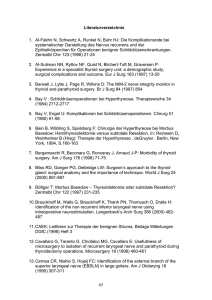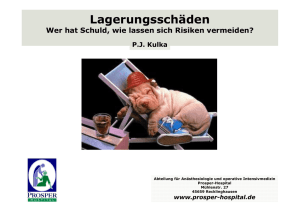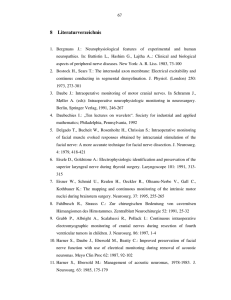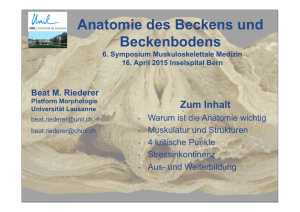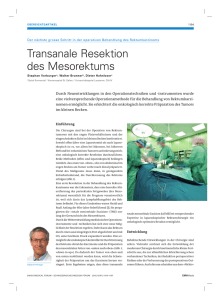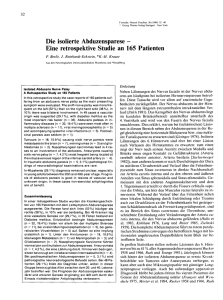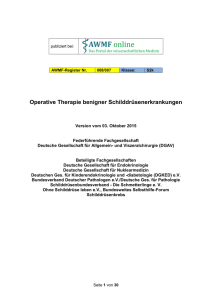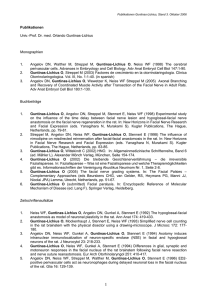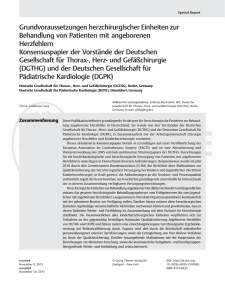Neuromonitoring
Werbung
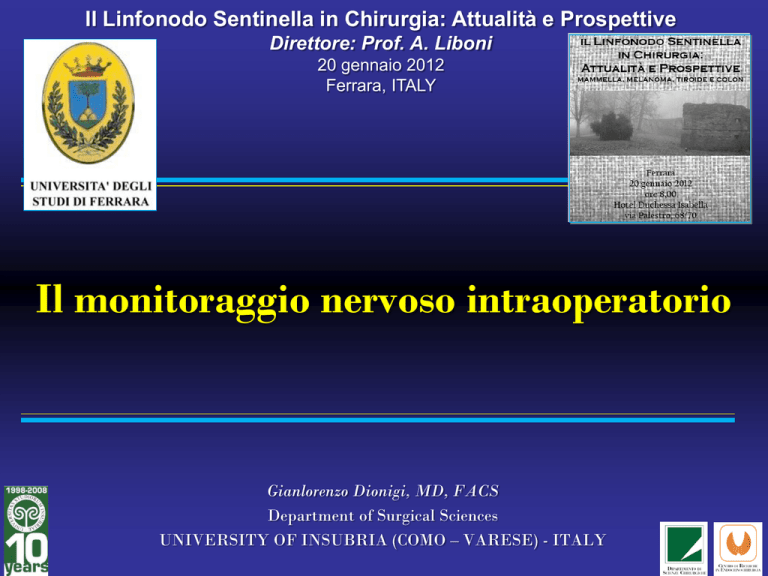
Il Linfonodo Sentinella in Chirurgia: Attualità e Prospettive Direttore: Prof. A. Liboni 20 gennaio 2012 Ferrara, ITALY Il monitoraggio nervoso intraoperatorio Gianlorenzo Dionigi, MD, FACS Department of Surgical Sciences UNIVERSITY OF INSUBRIA (COMO – VARESE) - ITALY This report does not endorse any specific Company or set of monitoring equipment Exposure of RLN reduce the rate of RLN injury No identification Localized RLN RLN Lahey FH, Ann Surg 1938 1.6 0.3 Riddell VH, Lancet 1956 3.5 2.1 Jazko, Surgery 1994 7.9% 1.2% Wagner, Br J Surg 1994 21% 6.9% Hermann, Ann Surg, 2002 2.1% 0.9% Dralle H, Surgery 2004 1.16% 0.63% Chiang, Surgery 2005 5.1% 0.9% Partially exposed RLN 0.3% - Completely dissected RLN 0.1% - Gold standards for RLN management 1. Extensive knowledge of RLN anatomy 2. Visual identification of RLN 3. Exposure of RLN 4. Experience & training 5. Pre- & post-op. laryngoscopy Why neuromonitoring? RLN and laryngeal anatomy are the basis of modern thyroid surgery Why do we need more than anatomical nerve identification? Neuromonitoring: history •Laryngeal palpation with stimulation of RLN: feel for laryngeal twitch •Riddell published in 1970, studies over 1946-1960 •Palpation of posterior crico-arytenoid muscle, with stimulation of 0.5-2.0mA •Galivan 1986 Evolution of RLN Monitoring • Intra-operative invasive techniques • Non-invasive surface electrodes Lamadé W Transtracheal monitoring of the recurrent laryngeal nerve. Prototype of a new tube Intraoperative monitoring of the recurrent laryngeal nerve. A new method Chirurg. 1996 & 1997 ETT ETT electrodes Stimulator probe NIM monitor RLN identified both visually and electrically Intraoperative evidence of RLN injury Evidence RLN injury Author Reference N % Bergenfelz A Langenbecks Arch Surg 2008 1/10 11.3% Chiang FY Surgery 2005 3/40 7.5% Lo CY Arch Surg 2000 5/33 15% Patlow CA Ann Surg 1986 1/10 10% Caldarelli D Otolaryngol Clin North Am 1980 1/10 10% Scandinavian Quality Register Thyroid Surgery Intraoperative RLN injury causes • • • • Section (mistake in surgical technique) Ligature (without transection) Mistake in hemostasis and dissection maneuvers Stretch/traction – Excessive traction during the medial traction of the thyroid lobe – Excessive aspiration near to the nerve (suction) • Compression/contusion/pressure • Thermal/electrical injury – Diffusion by haemostatic devices • Ischemia – Ligation of the inferior pole vessels before identifying RLN – Excessive dissection of the nerve with ischemia Types of nerve injury – neuropraxia: simple contusion of a nerve • treated by simple observation • return to normal function over weeks to months – axonotmesis: more significant disruption followed by degeneration • healing takes a prolonged time – neurotmesis: complete division of a nerve • requires surgical repair anatomical nerve lesions are only exceptional reasons for postop VC palsy Dralle H. WJS 2008 Bergenfelz A . Langenbecks Arch Surg 2008 Chiang FY . Surgery 2005 Lo CY . Arch Surg 2000 Patlow CA . Ann Surg 1986 Caldarelli D. Otolaryngol Clin North Am 1980 AUDIT True incidence of RLN injury • No routine post-operative laryngoscopy 0.3% RLNP • Routine postoperative laryngeal exams 7% RLNP 1. Evidence from the Literature (?) Transient RLN palsy Parameter Odds ratio P value Permanent RLN palsy Odds ratio P value Graves’ disease 1.40 <0.43 1.95 <0.37 Recurrent goiter 4.06 <0.0001 89.96 <0.0001 Thyroiditis 0.04 <0.83 0.02 <0.92 Uninodular goiter* 1.27 <0.41 1.43 <0.51 IONM 0.58 <0.008 0.30 <0.004 Am J Surg 2002 2. Evidence from the Literature (?) 19 Dralle H, WJS 2008 Reasons for RLN protection with IONM • Adds early and definite localization of RLN – To prevent visual misidentification – To avoid excessive traction – To identify extralaryngeal branches, anatomical variation, distored RLN, non-RLN • Adds confirmation of RLN • Adds dissection of RLN Nerve Identification 2mA Nerve Confirmation 1-0.5mA Nerve Confirmation 0.5mA Why neuromonitoring? The answer is very simple: based on anatomical nerve assessment alone 1. the frequency of postop VC dysfunction is more common than expected 2. because anatomical nerve lesions are only exceptional reasons for postop VC palsy Which is the fundamental difference between visual identification and RLN monitoring? RLN monitoring can change strategy Strategy changes in bilateral goiter 36 LOS at first side 16 unchanged strategy ↓ 9 (56%) unilateral palsy 3 (19%) bilateral palsy 20 changed strategy ↓ 20 (100%) unilateral palsy 0 bilateral palsy When LOS is real: How to treat RLN injury intraoperatively? Intraop steroids* (n=143) NAR Vocal corde palsy temporary permanent Recovery (days) No intraop steroids (n=152) 194 173 11 1 12 1 28.6 (10-36) 37.4 (14-61)** MEDICO-LEGAL ISSUES • Reduction of major injury to patient – Bilateral RLN palsy • Recorded nerve signal • Early differentiation between RLN related and unrelated voice changes • New standard of care (?) US thyroid surgery monitored Chiang FY, 2011 IONM procedures in Asia IONM PREVALENCE IN EUROPE Danmark 77% 2007 Godballe C, ETA Meeting, Lisbona, Poland 5% 2010 Barcinsky M, Polish Endocrine Surgeon Germany 90% 2011 Dralle H, Harvard Meeting, Boston France #6200 2008 Carnaille B, IONM study group France #10000 2010 Spain #613 Spain #1956 2009 Jan-april 2011 Carnaille B, IONM study group Manuel Poveda, Madrid 2010 Manuel Poveda, Madrid 2011 PREVALENCE IN ITALY source Medtronic Italy German Association of Endocrine Surgeons Langenbecks Arch Surg 2011;396(5): 639-649 http://www.dgch.de 2.6.1. Darstellung des Nervus laryngeus recurrens Funktionsstörungen des Nervus laryngeus recurrens sind mit Stimmstörungen, Schluckstörungen und Beeinträchtigungen der Atmung verbunden. Bei bilateraler Rekurrensparese ist häufig eine Tracheotomie erforderlich. Das Risiko, den N. laryngeus recurrens zu verletzen, wird durch das Ausmaß der Resektion und die individuelle Lagevariante des Nerven bestimmt. Die schonende, das heißt nicht-skelettierende, nervendurchblutungserhaltende präparative Darstellung des N. laryngeus recurrens mindert das Schädigungsrisiko und sollte grundsätzlich sowohl bei Primäreingriffen als auch bei Rezidiveingriffen durchgeführt werden (6, 18). Der visualisierte anatomische Nervenverlauf sollte vor und nach Resektion dokumentiert werden. Ausnahmsweise kann auf die Darstellung verzichtet werden, wenn sich die Resektionsebene in sicherem Abstand ventral der lateralen Grenzlamelle zum Nervenverlauf befindet (46). Die Nichtdarstellung des Nervus laryngeus recurrens soll begründend dokumentiert werden. Das intraoperative Neuromonitoring ersetzt nicht den Goldstandard der visuellen Nervendarstellung, sondern ist nur in Ergänzung zu dieser einsetzbar. Das Verfahren kann die Identität des Nervus laryngeus recurrens sicher bestätigen und seine Funktionsfähigkeit bei ungestörtem Überleitungssignal sehr wahrscheinlich machen, wobei zur Erfassung des gesamten Nervenverlaufes die Stimulation über den Nervus vagus vor und nach Resektion erforderlich ist (10, 17, 28, 48, 50). Die sicherste Methode zur Differenzierung zwischen Artefakten und Aktionspotenzialen ist die Ableitung von Elektromyogrammen. Eine signifikante Senkung des Rekurrenspareserisikos durch Einsatz des Neuromonitoring ist bislang nur bei Rezidiveingriffen gesichert (9, 28). Polish Journal of Surgery (transl). Guideline Statement of the Polish Study Group for Nerve Monitoring of the Polish Club of the Endocrine Surgeons Members of the Study Group for Nerve Monitoring of the Polish Club of Endocrine Surgery during the conference on 16th of April 2011 in Krakow opine that centers of thyroid surgery in Poland should be equipped with nerve integrity monitoring systems. Following the analysis of the published data and based on our own experience the need to introduce routine training courses of standardized technique of electrophysiological monitoring of the recurrent nerves and employment of this technique in selected thyroid operations was recognized". Neuromonitoring for residents in surgical training • Incorporating new technology • Teaching aid • Elucidate errors • Less-experienced surgeons – IONM decrease RLN paralysis (Dralle H, 2004) LIMITATIONS OF IONM 1. RLN palsy still occur 2. need for standardized and well-trained use to avoid pitfalls 3. knowledge of most-common pitfalls 4. ability to use troubleshooting algorithms 5. IONM does not replace clinical judgment 6. relatively low positive predictive value 7. cost-effectiveness is still not evaluated 8. need for further research focused on neurophysiology of the RLNs 9. IONM of the external branch of the superior laryngeal nerve 10. thyroidectomy in local anesthesia Conclusions Why should RLN be monitored in any bilateral case ? • RLN monitoring improves – Nerve ID (Randolph GW, 2002) – Clarification of RLN anatomy (Delbridge 2002) – Nerve dissection (Chan WF 2006) – Reoperations with pre-existing RLN morbidity (Gorentzy P, 2008) • Intraoperative assessment of RLN function (non postoperative) – Intraoperative prediction of post-operative function (prognosis) (Timmermann W, 2004) – Prevention of bilateral RLN injury: “one-stage thyroidectomy” (Randolph GW, 2002) – Elucidate where and how the RLN was injured (intraoperative evidence) (Chan WF 2006) – Early differentiation between RLN related and unrelated voice changes (Dralle H 2004) IONM technology in thyroid surgery (IONM: intraoperative neuromonitoring) IMPLICATIONS CLINICAL PRACTICE RESEARCH EDUCATION MEDICO-LEGAL Surgeons should not overstate benefits of neuromonitoring to patients Modern Surgery • ERADICATION OF DISEASE • SAFETY OF PROCEDURE • DOCUMENTATION
